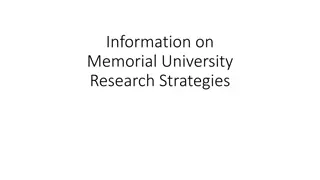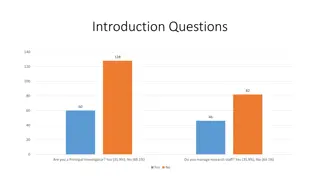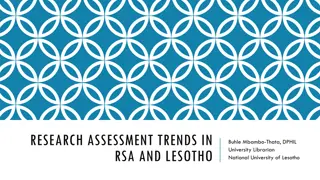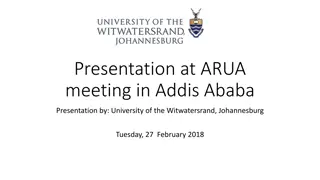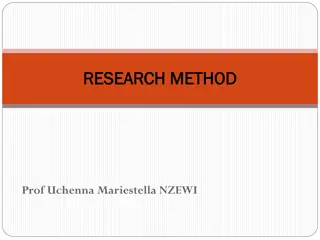
Understanding Quantitative Research in Education
Explore the characteristics, types, and processes of quantitative research in education, focusing on data collection, analysis, and the importance of sampling for statistical significance. Learn how quantitative research operates on the belief in a stable, measurable world and how researchers use hypotheses, control factors, and samples to derive meaningful insights.
Download Presentation

Please find below an Image/Link to download the presentation.
The content on the website is provided AS IS for your information and personal use only. It may not be sold, licensed, or shared on other websites without obtaining consent from the author. If you encounter any issues during the download, it is possible that the publisher has removed the file from their server.
You are allowed to download the files provided on this website for personal or commercial use, subject to the condition that they are used lawfully. All files are the property of their respective owners.
The content on the website is provided AS IS for your information and personal use only. It may not be sold, licensed, or shared on other websites without obtaining consent from the author.
E N D
Presentation Transcript
QUANTITATIVE RESEARCH CHARACTERISTICS AND TYPES
General Types of Educational Research Descriptive survey, historical, content analysis, qualitative Associational correlational, causal-comparative Intervention experimental, quasi-experimental, action research (sort of) This division is irrespective of the quan/qual divide
QUANTITATIVE RESEARCH Quantitative research is the collection and analysis of numerical data to describe, explain, predict, or control phenomena of interest.
Quantitative Research This research operates on the philosophical belief or assumption that we inhabit a relatively stable, uniform, and coherent world that we can measure, understand, and generalize about. This view, adopted from the natural sciences, implies that the world and the laws that govern it are somewhat predictable and can be understood by scientific research and examination. In this quantitative perspective, claims about the world are not considered meaningful unless they can be verified through direct observation.
THE QUANTITATIVE PROCESS At the outset of a study, quantitative researchers state the hypotheses to be examined and specify the research procedures that will be used to carry out the study. They also maintain control over contextual factors that may interfere with the data collection and identify a sample of participants large enough to provide statistically meaningful data.
Sampling The first step in selecting a sample is to define the population to which one wishes to generalize the results of a study The sample is drawn from the population -Data is collected from the sample -Statistics are used to determine how likely the sample results are reflective of the population
A number of different strategies can be used to select a sample. Each of the strategies has strengths and weaknesses. There are times when the research results from the sample cannot be applied to the population because threats to external validity exist with the study. The most important aspect of sampling is that the sample represent the population.
SIMPLE RANDOM SAMPLING Each subject in the population has an equal chance of being selected regardless of what other subjects have or will be selected. A random number table or computer program is often employed to generate a list of random numbers to use. A simple procedure is to place the names from the population is a hat and draw out the number of names one wishes to use for a sample.
STRATIFIED RANDOM SAMPLING A representative number of subjects from various subgroups is randomly selected. The subgroups are called strata and the sample drawn from each strata is proportionate to the propsrtions of the strata in the sample E.g. if a population has 100 teachers (50 elementary, 30 secondary and 2 tertiary), then in a sample of 10, 5 should be from the elementary stratum, 3 from secondary stratum and 2 from the tertiary stratum
CLUSTER SAMPLING In cluster sampling, intact groups, not individuals, are randomly selected. Any location within which we find an intact group of population members with similar characteristics is a cluster. Examples of clusters are classrooms, schools, city blocks, hospitals, and department stores.
When is it used? Cluster sampling is done when the researcher is unable to obtain a list of all members of the population. It is also convenient when the population is very large or spread over a wide geographic area. For example, instead of randomly selecting from all fifth graders in a large city, you could randomly select fifth-grade classrooms and include all the students in each classroom. Cluster sampling usually involves less time and expense and is generally more convenient
An extension of the Cluster Random Sample is the TWO-STAGE CLUSTERE RANDOM SAMPLE. In this situation, the clusters (classes in our example) are randomly selected and then students within those clusters are randomly selected.
CONVENIENCE SAMPLING Subjects are selected because they are easily accessible. This is one of the weakest sampling procedures. An example might be surveying students in one s class. Generalization to a population can seldom be made with this procedure.
PURPOSIVE SAMPLING Subjects are selected because of some characteristic. Also referred to as judgment sampling and is the process of selecting a sample that is believed to be representative of a given population. Sample selection is based on the researcher s knowledge and experience of the group to be sampled using clear criteria to guide the process.
SYSTEMATIC SAMPLING Systematic sampling is an easier procedure than random sampling when you have a large population and the names of the targeted population are available. Systematic sampling involves selection of every nth (i.e., 5th) subject in the population to be in the sample. Suppose you had a list of 10,000 voters in your area and you wished to sample 400 voters for research We divide the number in the population (10,000) by the size of the sample we wish to use (400) and we get the interval we need to use when selecting subjects (25). In order to select 400 subjects, we need to select every 25th person on the list.
Ethics of Research Researchers are bound by a code of ethics that includes the following protections for subjects Protected from physical or psychological harm (including loss of dignity, loss of autonomy, and loss of self-esteem) Protection of privacy and confidentiality Protection against unjustifiable deception The subject must give voluntary informed consent to participate in research. Guardians must give consent for minors to participate. In addition to guardian consent, minors over age 7 (the age may vary) must also give their consent to participate.
Informed Consent All research participants must give their permission to be part of a study and they must be given pertinent information to make an informed consent to participate. This means you have provided your research participants with everything they need to know about the study to make an informed decision about participating in your research. Researchers must obtain a subject s (and parents if the subject is a minor) permission before interacting with the subject or if the subject is the focus of the study. Generally, this permission is given in writing; however, there are cases where the research participant s completion of a task (such as a survey) constitutes giving informed consent.
INSTRUMENT Instrument is the generic term that researchers use for a measurement device (survey, test, questionnaire, etc.). To help distinguish between instrument and instrumentation, consider that the instrument is the device and instrumentation is the course of action (the process of developing, testing, and using the device).
Instruments fall into two broad categories, researcher-completed and subject-completed, distinguished by those instruments that researchers administer versus those that are completed by participants. Researchers chose which type of instrument, or instruments, to use based on the research question.
Usability Usability refers to the ease with which an instrument can be administered, interpreted by the participant, and scored/interpreted by the researcher. Example usability problems include: Students are asked to rate a lesson immediately after class, but there are only a few minutes before the next class begins (problem with administration). Students are asked to keep self-checklists of their after school activities, but the directions are complicated and the item descriptions confusing (problem with interpretation).
VALIDITY Validity is the extent to which an instrument measures what it is supposed to measure and performs as it is designed to perform. It is rare, if nearly impossible, that an instrument be 100% valid, so validity is generally measured in degrees. There are numerous statistical tests and measures to assess the validity of quantitative instruments, which generally involves pilot testing.
External validity is the extent to which the results of a study can be generalized from a sample to a population. Establishing eternal validity for an instrument, depends directly on sampling. An instrument that is externally valid helps obtain population generalizability, or the degree to which a sample represents the population. Content validity refers to the appropriateness of the content of an instrument. In other words, do the measures (questions, observation logs, etc.) accurately assess what you want to know? This is particularly important with achievement tests.
RELIABILITY A test is reliable to the extent that whatever it measures, it measures it consistently. Does the instrument consistently measure what it is intended to measure? There are 4 estimators to gauge reliability: Inter-Rater/Observer Reliability: The degree to which different raters/observers give consistent answers or estimates. Test-Retest Reliability: The consistency of a measure evaluated over time. Parallel-Forms Reliability: The reliability of two tests constructed the same way, from the same content. Internal Consistency Reliability: The consistency of results across items.
Definition: Descriptive research involves collecting data to test hypotheses or to answer questions about people s opinions on some topic or issue. Survey is in an instrument to collect data that describes one or more characteristics of a specific population. Survey data are collected by asking members of population a set of questions via a Questionnaire or an Interview. Descriptive research requires attention to the selection of an adequate sample and an appropriate instrument.
Rsearch Design point in time Collects data at one Cross-sectional Survey can be categorized as Collects data at more than one time to measure growth or change Longitudinal
Conducting Descriptive Research It requires a collection of standardized quantifiable information from all members of a population or sample . Is a written collection of self report questions to be answered by selected group of research participants. Questionnaire Is an oral ,in-person question and answer session between a researcher and individual respondent. Interview
Constructing The Questionnaire A Questionnaire should be attractive ,brief and easy to respond . No item should be included that does not directly relate to the objective of the study. Structured or closed ended should be used. Common structured items used in questionnaire are scaled items , ranked items and checklists. In an Unstructured item format respondents have complete freedom of response but often are difficult to analyze and interpret.
Each question should focus on : Terms and meaning should be defined. Single concept Clear wording Questionnaire should begin with general, Non threatening questions. Avoid leading questions
Pilot Testing The questionnaire should be tested by respondent who are similar to those in the sample of the study. Pilot testing provides information about deficiencies as well as suggestions for improvement. Omission or unclear or irrelevant items should be revised. Pilot testing or review by colleagues can provide a measure of content validity.
Cover Letter Every mailed or Emailed questionnaire must be accompanied by cover letter that explains What is being asked and why is being asked. The cover letter should be brief, neat and addressed to the specific individual.
Selecting Participants Participants should be selected using an appropriate sampling technique. The researcher should ensure that the identified participants should have the desired information and must be willing to share it .
Distributing the Questionnaire Questionnaires are usually distributed via one of five approaches: email mail telephone Personal administration interview
Tabulating Questionnaireresponses The simplest way to present the result is to indicate the percentage of respondents who selected each alternative for each item. However analyzing summed items clusters-groups items focused on the same issues is more useful , meaningful and reliable. Comparison can be investigated in the collected data by examining the responses of different sub-groups in the sample (male/female).
6 4 Series 1 2 Series 2 0 Series 3 Sales 1st Qtr 2nd Qtr 3rd Qtr 4th Qtr












